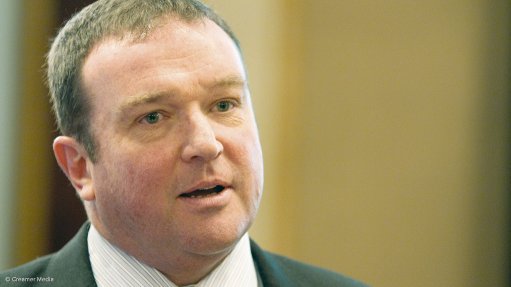
Coal Roadmap chair Ian Hall
Photo by: Duane Daws
JOHANNESBURG (miningweekly.com) – New coal mines were urgently needed in South Africa and infrastructure provision in the emerging Waterberg coalfield must begin “just to keep the lights on”, South African Coal Roadmap chairperson Ian Hall reiterated on Tuesday.
Hall - who together with World Wildlife Fund South Africa (WWF-SA) sustainable business programme manager Malango Mughogho and Mac Consulting principal consultant Dave Collins took part in a Mac-hosted discussion on the impact of energy generation on climate change - was responding to Mughogho’s call for South Africa’s coal-heavy strategic infrastructure projects (SIPs) to be realigned to assure a lower carbon future.
Hall pointed out that it was only last week that South Africans had been called upon to use 10% less electricity, which had again highlighted how dependent the country was on Eskom’s coal-fired power stations.
Even if South Africa chose to implement the most aggressive decarbonising programme imaginable, its existing fleet of coal power stations would still have to be kept going.
“Indeed, new coal mines are urgently required and, just to keep the lights on, it is prudent to start development of infrastructure to the Waterberg,” Hall said, in response to the WWF-SA manager’s SIP-rejigging suggestion.
Earlier, Collins had put paid to the world being able to decarbonise its energy systems in time to prevent climate change.
“We’re not going to change in time and adaptation is what we’re going to have to settle for because we’re not going to fix the problem,” Collins concluded.
Mughogho said governments’ adherence to preventing an average world temperature rise above two degrees was essential and that the South African government’s coal-heavy SIP plans militated against staying within the two-degree temperature band.
While South Africa was unlikely to be given financial assistance for climate-change adaptation, it could source funding for climate-change mitigation, which, she argued, could conceivably be used to subsidise the switch of listed coal companies out of coal and into other areas of business.
“These are the conversations we need to have now, in terms of our long-term planning,” Mughogho added.
But Hall concurred on the need for adaptation and pointed to the Roadmap recommendation of South Africa continuing to work on reducing coal’s environmental impact as well as improving power station efficiencies against the background of a 1% improvement in the thermal efficiency of a coal power station yielding a 2% to 3% reduction in carbon dioxide (C02) emission.
If South Africa’s coal plants, which are currently operating at a thermal efficiency of 35%, were lifted to 45% efficiency, CO2 emission would be cut meaningfully.
“In fact, by upgrading older, smaller plants, you could actually reduce total global emissions by 5.5%, which is more than all of the intentions of the Kyoto Protocol,” Hall said, adding that the Germans were already steering down that path by decommissioning old coal power stations and introducing 5 300 MW of new efficient coal-fired capacity.
No matter what mitigation steps were taken, coal would remain essential to electricity production for decades to come.
“Despite all the bad press, coal has been growing at a phenomenal rate, faster than at any time in history,” Hall added.
Coal exports were also indispensible to South Africa, particularly at this time of a precarious current account deficit.
Coal accounted for 45% of total worldwide energy demand growth in the last ten years – nearly as much natural gas, oil and renewables put together.
The mineral was also poised to be the second-biggest source of primary energy and the biggest source for electricity generation in the next 30 years, during which time South Africa’s power utility Eskom alone would need four-billion additional tons of coal, over and above what it had already burnt.
At least five large Eskom power stations would still be in operation after 2040.
In terms of sales value, coal was the most valuable mineral in South Africa and was essential not only for electricity generation and poverty alleviation but also steel, cement, transport fuels and chemicals.
The position of most large coal companies was that a sustainable climate change response needed to integrate environmental imperatives with energy security, economic development and poverty alleviation.
So many people throughout the world were still without access to electricity and divorcing clean energy from economic development was wrong.
Most coal producers also accepted that a diverse energy mix was needed to secure, affordable and sustainable energy.
“We must have alternatives. The fact is, though, we still need coal,” Hall emphasised.
The members of the World Coal Association were committed to reducing greenhouse-gas (GHG) emissions and participating in solutions that minimised GHG emissions from coal, including through carbon capture and storage.
Meanwhile, the 67-billion tons of coal that the Council for Geosciences (CGS) reported South Africa as having, still needed to be categorised as either a resource or as a reserve to be meaningful.
Many observers are calling on CGS to conduct a compliant coal inventory survey in keeping with South Africa’s acute dependence on coal and the need for officially recognised measurements to be applied to the country’s future coal potential.